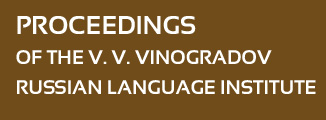MORPHOLOGICAL AND SYNTACTYC VARIANTS IN NUMERALS двA, џба, дв0и, nбои2, дв0е, nбоE IN THE SOURCES FOR THE COMPREHENSIVE DICTIONARY OF MODERN CHURCH SLAVONIC
Abstract:
vatives as well as the combinations of these words with variant forms of nouns and, in some cases, verbs on the material of Church Slavonic texts of Modern Times. In particular, it was revealed that as forms of the nominative and accusative of neuter gender are usually used not the forms двЁ and џбэ, but the forms двA and џба; forms of feminine gender двЁ and џбэ are much more often combined with nouns in the plural form than the forms of masculine (and neuter) gender двA and џба, with which the use of the plural form of nouns of masculine gender in the genitive case is also found. Finite forms of verbs as predicate in dual and plural in the combinations of двA and џба with nouns of masculine gender as subjects are diff erently distributed in two groups of sources. The form of the genitive and prepositional case двY is quite widely represented along with двою2, but shows a number of signifi cant diff erences: apparently there are no cases of its use outside of a combination with nouns, while the plural form of the latter occurs here far more frequently. The dual form of nouns of all three genders is preferred in combinations with the forms of oblique cases двэмA, nбёма and nбою2. Words дв0и, дв0е, oбоE, oбои2 (nбоS) show diff erences in nominative-accusative and oblique cases, as well as in combinations with animate and inanimate nouns. Regarding to most of the studied words, it is possible to state the extremely rare use of the form of a genitive as an accusative case with animated nouns.


